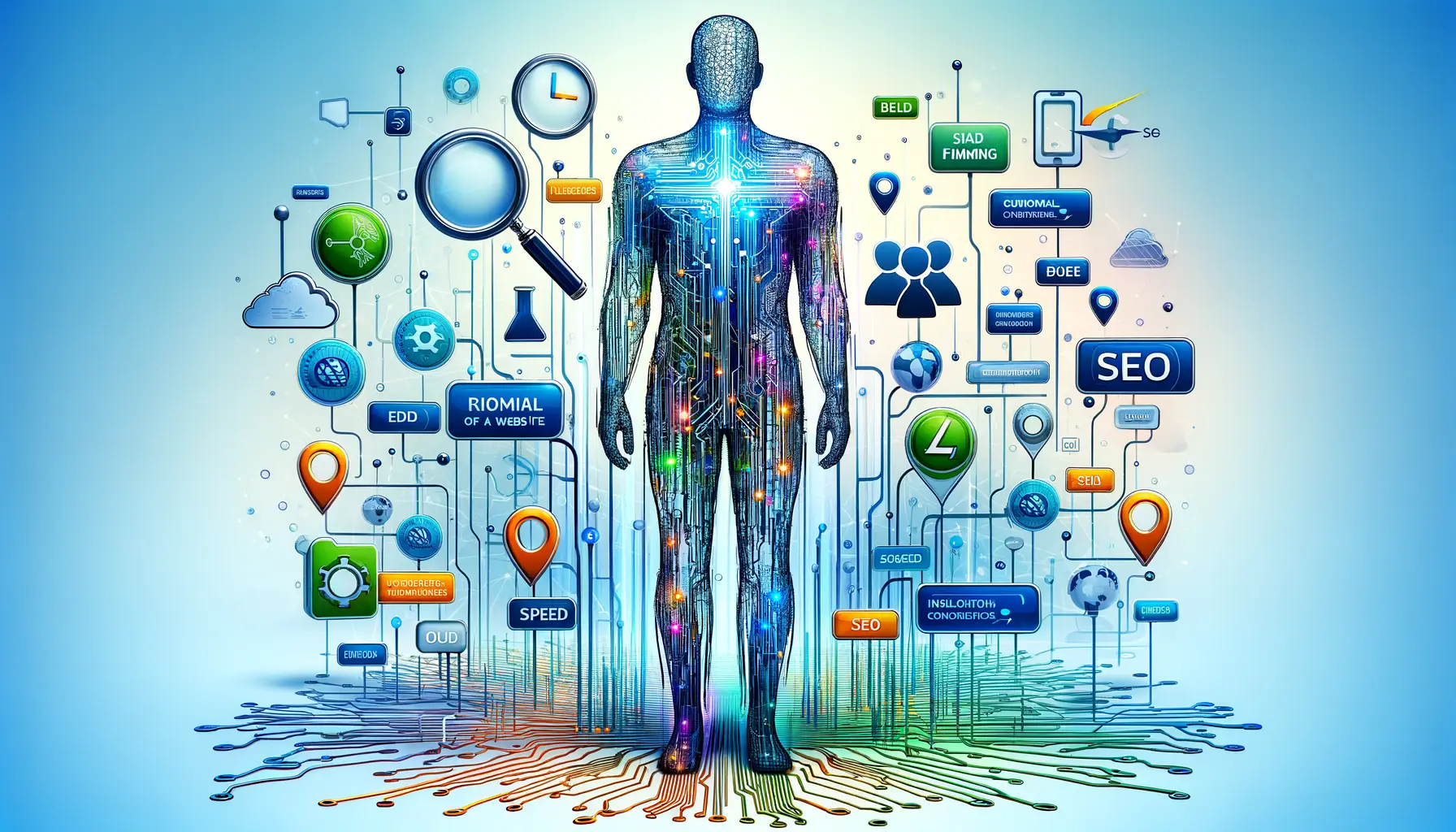In the digital age, the evolution of content management systems (CMS) has taken a significant leap forward with the introduction of headless CMS.
This innovative approach to content management separates the back-end content repository from the front-end presentation layer, offering unparalleled flexibility and control over how content is delivered across various platforms.
As businesses strive to enhance their online presence, understanding the synergy between headless CMS and on-page SEO becomes crucial.
This article delves into the intricacies of leveraging headless CMS for on-page SEO, providing insights into how businesses can optimize their content for search engines while maintaining a dynamic and engaging user experience.
The shift towards headless CMS represents a paradigm change in web development and content management, emphasizing the need for a more agile and adaptable approach to content delivery.
By decoupling the content management from its presentation, headless CMS allows developers to use their preferred tools and frameworks to create rich, interactive user experiences.
However, this flexibility also introduces new challenges for on-page SEO, as traditional SEO techniques need to be reimagined to fit this modern architecture.
This guide aims to explore the strategies and best practices for integrating on-page SEO with headless CMS, ensuring that your content not only reaches its intended audience but also ranks well on search engine results pages (SERPs).
- Understanding Headless CMS
- Key On-Page SEO Strategies for Headless CMS
- Advanced SEO Techniques for Headless CMS
- Content Modeling for SEO Success
- Integrating Headless CMS with SEO Tools
- Challenges and Solutions in Headless CMS SEO
- Future Trends in Headless CMS and SEO
- Embracing the Future of Headless CMS and SEO
- Headless CMS and SEO FAQs
Understanding Headless CMS
What is Headless CMS?
At its core, a headless CMS is a content management system that provides a way to store and deliver content without a front-end delivery layer.
Unlike traditional CMS platforms that come with a predefined front-end system, headless CMS offers a back-end only content management solution.
This means that the content stored in a headless CMS can be published anywhere, through any framework or technology, via APIs.
This architecture offers unprecedented flexibility, allowing developers to build custom front-ends that can consume the CMS content in any form or shape required.
The headless approach caters to the growing need for omnichannel content delivery, enabling businesses to distribute their content across multiple platforms such as websites, mobile apps, IoT devices, and more, without being tied to a specific presentation layer.
This flexibility is particularly beneficial in today’s fast-paced digital landscape, where consumer behaviors and technology platforms are constantly evolving.
Benefits of Headless CMS for SEO
One of the key advantages of using a headless CMS is the improved performance and loading times of the websites and applications it powers.
Since the front-end is developed independently, developers can optimize the site’s speed and responsiveness, which are critical factors for SEO and user experience.
Faster websites not only provide a better user experience but also rank higher in search engine results, as page speed is a known ranking factor for Google.
Another significant benefit is the enhanced control over the content and its structure.
With headless CMS, SEO specialists and content creators can ensure that the content is semantically correct and structured in a way that search engines understand.
This includes the ability to implement schema markup, meta tags, and other SEO-friendly practices directly within the content repository, making it easier to manage and optimize the content for search engines across all platforms.
Headless CMS offers unparalleled flexibility in content delivery and management, providing a solid foundation for implementing effective on-page SEO strategies across multiple platforms.
Key On-Page SEO Strategies for Headless CMS
Adapting on-page SEO strategies for a headless CMS environment requires a nuanced understanding of how content is managed and delivered.
Without the traditional front-end interface, SEO professionals must focus on optimizing the content at the source and ensuring seamless integration with the presentation layer.
Here are several strategies to effectively leverage on-page SEO within a headless CMS framework:
Optimizing Content Structure and Quality
Content is the cornerstone of SEO, and its importance is magnified in a headless CMS setup.
To optimize content structure and quality:
- Ensure that all content is well-organized, logically structured, and easily accessible to search engines.
- Use semantic HTML tags within the content repository to highlight important elements such as headings, lists, and links.
- Maintain high-quality, engaging content that addresses the needs and questions of your target audience, incorporating relevant keywords naturally.
Implementing SEO-Friendly URLs
SEO-friendly URLs are crucial for better indexing and ranking.
For headless CMS:
- Develop clear, descriptive URLs that reflect the content of the page and include target keywords.
- Avoid using automatically generated URLs with numbers or nonsensical strings.
- Ensure that the CMS allows for custom URL structures and easy editing of slugs to maintain consistency across your digital presence.
Enhancing Meta Tags and Descriptions
Meta tags and descriptions play a significant role in on-page SEO by providing search engines with concise summaries of your content.
To optimize them in a headless CMS:
- Include editable fields for meta titles and descriptions in your content model, allowing for customization for each piece of content.
- Ensure meta titles are compelling and include main keywords towards the beginning.
- Write meta descriptions that accurately summarize the page content and include a call to action, making them appealing to search engine users.
Utilizing Schema Markup
Schema markup enhances the way your pages are represented in SERPs, providing richer information to search engines and improving the chances of featured snippets.
Implementing schema markup involves:
- Adding relevant schema types to your content, such as articles, products, or events, directly within the headless CMS.
- Ensuring that the CMS supports dynamic insertion of schema markup based on the content type and attributes.
While headless CMS platforms offer greater flexibility in content delivery, they require a proactive approach to on-page SEO to ensure content is fully optimized for search engines.
Advanced SEO Techniques for Headless CMS
As the digital landscape becomes increasingly competitive, leveraging advanced SEO techniques is crucial for businesses using headless CMS to stand out.
These methods go beyond basic on-page optimization, focusing on enhancing search visibility and user engagement through technical and strategic SEO practices.
Dynamic Content Optimization
Dynamic content optimization involves tailoring content to meet the specific needs and search intent of different user segments.
In a headless CMS:
- Utilize server-side rendering or static site generation to ensure dynamic content is crawlable and indexable by search engines.
- Implement personalization strategies that adjust content based on user behavior, location, or device, without compromising SEO.
Mobile Optimization
With mobile devices accounting for a significant portion of web traffic, optimizing for mobile is non-negotiable.
For headless CMS users:
- Adopt responsive design principles to ensure content displays correctly across all devices.
- Focus on improving mobile page speed by optimizing images, leveraging browser caching, and minimizing code.
- Use Google’s Mobile-Friendly Test tool to identify and fix mobile usability issues.
International SEO
For businesses targeting multiple countries or languages, international SEO is critical.
Headless CMS platforms can support these efforts by:
- Allowing for the easy creation and management of multilingual content, ensuring each version is properly tagged with the correct language and regional codes.
- Implementing hreflang tags to signal to search engines which version of the content is relevant for specific geographic or language-based audiences.
Link Building and Content Promotion
Effective link building and content promotion are essential for improving domain authority and driving traffic.
Strategies include:
- Creating high-quality, shareable content that naturally attracts backlinks.
- Engaging in guest blogging and partnerships with reputable sites in your industry.
- Using social media and email marketing to promote content and encourage shares and links.
Incorporating advanced SEO techniques into your headless CMS strategy not only enhances your site’s search engine visibility but also provides a superior user experience, fostering engagement and conversions.
Content Modeling for SEO Success
Content modeling is a fundamental aspect of working with headless CMS that directly impacts SEO performance.
It involves defining the structure of your content in a way that is both meaningful to users and search engines.
A well-thought-out content model ensures that your site’s architecture is optimized for discoverability, relevance, and user engagement.
Defining Content Types and Relationships
Start by identifying the main types of content your site will offer, such as blog posts, product pages, or customer testimonials.
For each content type, determine the attributes that describe it best, like title, description, author, or price.
This structured approach not only makes content management more efficient but also enhances SEO by ensuring that key information is consistently presented and easily indexed by search engines.
Equally important is defining the relationships between different content types.
For example, a blog post might be related to a specific product or author.
Establishing these connections within your headless CMS helps to create a rich, interconnected content ecosystem that boosts internal linking, a critical factor for SEO.
Implementing SEO-Friendly Fields
In your content model, include fields specifically designed for SEO optimization, such as:
- SEO title and meta description fields that can be customized for each piece of content.
- A field for slug customization to ensure URLs are readable and keyword-rich.
- Fields for alt text on images to improve image search visibility and accessibility.
By incorporating these SEO-focused fields into your content model, you empower content creators to optimize each piece of content for search engines directly within the CMS, streamlining the SEO process and enhancing overall site performance.
A strategic approach to content modeling is crucial for leveraging the full SEO potential of a headless CMS, enabling businesses to structure their content in a way that is both user-friendly and search engine optimized.
Integrating Headless CMS with SEO Tools
For businesses leveraging headless CMS, integrating with SEO tools and platforms can significantly enhance their SEO strategy.
These integrations provide valuable insights into website performance, keyword rankings, and user behavior, allowing for data-driven optimization decisions.
Here’s how to effectively integrate headless CMS with SEO tools:
Connecting with Analytics Platforms
Integrating your headless CMS with analytics platforms like Google Analytics or Adobe Analytics is essential for tracking website performance and user engagement.
This involves:
- Implementing tracking codes within the head or via API calls to ensure all user interactions are captured.
- Setting up goals and conversion tracking to measure the effectiveness of your SEO efforts.
- Utilizing the data collected to identify trends, optimize content, and improve user experience.
Analytics integration helps you understand how visitors interact with your content, providing insights into areas for improvement and opportunities for optimization.
SEO Monitoring and Reporting Tools
SEO monitoring tools like Ahrefs, SEMrush, or Moz offer comprehensive features for tracking keyword rankings, backlink profiles, and competitor analysis.
To leverage these tools with a headless CMS:
- Use APIs provided by these platforms to pull data directly into your CMS dashboard for easy access and monitoring.
- Regularly review SEO metrics and reports to identify areas where your content can be improved or updated to maintain high search rankings.
By integrating SEO monitoring tools, you can keep a pulse on your SEO performance and make informed decisions to enhance your strategy.
Content Optimization Plugins and Tools
While traditional plugins may not be compatible with headless CMS, many tools offer APIs or web services that can be integrated for content optimization.
This includes:
- Grammar and readability checkers to ensure content quality.
- Keyword density analyzers to optimize content for target keywords without over-optimization.
- Schema markup generators to enhance content visibility in SERPs with rich snippets.
These integrations allow for real-time content optimization, ensuring that every piece of content is fully optimized before publication.
Integrating your headless CMS with SEO tools and platforms is a powerful strategy to enhance your SEO efforts, providing the insights and capabilities needed to drive traffic, improve rankings, and engage users effectively.
Challenges and Solutions in Headless CMS SEO
While headless CMS offers numerous advantages for content management and delivery, it also presents unique challenges for SEO.
Understanding these challenges is the first step towards devising effective solutions to ensure your SEO efforts are not compromised in a headless environment.
Technical SEO Considerations
One of the primary challenges with headless CMS is ensuring that technical SEO elements are correctly implemented.
Since the CMS only manages content without a front-end, SEO professionals must work closely with developers to:
- Ensure that the website’s structure is SEO-friendly, with proper use of headings, meta tags, and schema markup.
- Implement server-side rendering or static site generation to make JavaScript-heavy sites crawlable by search engines.
- Monitor and optimize website loading times, as performance is a key ranking factor.
Collaboration between SEO teams and developers is crucial to address these technical SEO considerations effectively.
Content Discoverability
Another challenge is ensuring that all content is discoverable by search engines.
In a headless setup, content might be dynamically loaded or served through APIs, which can hinder search engine crawlers.
Solutions include:
- Using pre-rendering services or server-side rendering to ensure content is fully loaded in the HTML before it reaches the browser.
- Creating and maintaining an up-to-date XML sitemap that search engines can use to discover and index content.
- Implementing comprehensive internal linking strategies to improve content discoverability and site authority.
Ensuring content discoverability requires strategic planning and ongoing optimization to adapt to the evolving search engine algorithms.
Content and SEO Management
Managing SEO within a headless CMS can also be challenging due to the separation of content from presentation.
To overcome this, businesses can:
- Adopt a content-first approach, where SEO considerations are integrated into the content creation process from the start.
- Utilize headless CMS features that allow for SEO metadata management, such as custom fields for titles, descriptions, and alt texts.
- Invest in training for content creators and marketers on SEO best practices to ensure content is optimized before publication.
Effective management of content and SEO in a headless environment requires a shift in mindset and processes, emphasizing the importance of SEO from the outset of content creation.
Assuming headless CMS automatically solves all SEO challenges is a common misconception. In reality, it requires careful planning, collaboration, and ongoing optimization to fully leverage its SEO potential.
Future Trends in Headless CMS and SEO
The digital landscape is continually evolving, and with it, the strategies for managing content and optimizing for search engines.
Headless CMS is at the forefront of this evolution, offering flexibility and scalability that traditional CMSs cannot match.
As we look to the future, several trends are set to shape the relationship between headless CMS and SEO, offering new opportunities and challenges for digital marketers and developers alike.
AI and Machine Learning Integration
Artificial intelligence (AI) and machine learning are becoming increasingly integral to SEO strategies.
In the context of headless CMS, these technologies can be leveraged to:
- Analyze user behavior and personalize content delivery in real-time, improving user engagement and SEO.
- Automate content optimization, from keyword analysis to meta tag generation, making SEO more efficient.
- Predict SEO trends and adapt content strategies accordingly, staying ahead of the competition.
The integration of AI and machine learning with headless CMS promises to revolutionize how content is optimized for search engines, making processes more data-driven and dynamic.
Increased Focus on Voice Search and IoT
As voice search becomes more prevalent and the Internet of Things (IoT) continues to expand, optimizing content for these platforms is becoming crucial.
Headless CMS is uniquely positioned to support this trend by:
- Facilitating the creation of structured content that can be easily accessed and interpreted by voice assistants and IoT devices.
- Enabling businesses to deliver content seamlessly across a wide range of devices and platforms, from smart speakers to wearable technology.
Adapting SEO strategies to include voice search and IoT will be essential for businesses looking to stay relevant in an increasingly connected world.
Greater Emphasis on User Experience (UX)
User experience is a critical factor in SEO, influencing everything from site structure to content quality.
With headless CMS, the focus on UX is expected to intensify, with trends pointing towards:
- Developing more interactive and immersive web experiences that keep users engaged and reduce bounce rates.
- Utilizing headless CMS to deliver content faster and more reliably, improving site speed and performance.
- Creating consistent omnichannel experiences that meet users where they are, enhancing brand visibility and search rankings.
As these trends continue to evolve, the synergy between headless CMS and SEO will become even more critical.
Businesses that can effectively navigate this landscape will be well-positioned to achieve digital success, driving traffic, engagement, and conversions through strategic content management and optimization.
Embracing the future trends in headless CMS and SEO requires a proactive and innovative approach, focusing on leveraging new technologies, optimizing for emerging platforms, and prioritizing user experience above all.
Embracing the Future of Headless CMS and SEO
The journey through the intricacies of headless CMS and its impact on on-page SEO reveals a landscape ripe with opportunities and challenges.
As businesses and content creators adapt to this evolving digital ecosystem, the importance of a strategic approach to SEO in a headless CMS context cannot be overstated.
The flexibility and scalability offered by headless CMS platforms provide a robust foundation for implementing advanced SEO strategies, ensuring content reaches its intended audience effectively.
Strategic Integration for SEO Success
Integrating headless CMS with SEO requires a thoughtful strategy that encompasses technical optimization, content structure, and user experience.
The future trends in digital marketing, including AI, voice search, and IoT, further underscore the need for a dynamic and adaptable SEO approach.
By leveraging the capabilities of headless CMS, businesses can:
- Enhance content discoverability and engagement across multiple platforms.
- Optimize for emerging technologies and user behaviors.
- Deliver personalized and immersive user experiences.
Collaboration and Innovation
The successful integration of headless CMS and SEO hinges on collaboration between developers, SEO professionals, and content creators.
This collaborative effort ensures that technical SEO considerations are woven into the fabric of the content management process, from content modeling to dynamic content optimization.
Innovation in content delivery and optimization strategies will be key to staying competitive in the search rankings and meeting the evolving expectations of users.
Looking Ahead
As we look to the future, the synergy between headless CMS and on-page SEO will continue to shape the digital marketing landscape.
Businesses that embrace this integration, adapting to new trends and technologies, will be well-positioned to thrive in an increasingly complex and competitive online environment.
The journey of optimizing for headless CMS is one of continuous learning and adaptation, but the rewards in terms of SEO success and user engagement are well worth the effort.
In conclusion, the evolution of headless CMS presents a unique opportunity to redefine on-page SEO strategies.
By embracing the flexibility, scalability, and innovation offered by headless CMS, businesses can unlock new potentials for content delivery and search engine visibility.
The future of digital content management and optimization is headless, and those who navigate this transition with strategic foresight and collaborative effort will lead the way in the digital frontier.
Want your website to top Google search rankings? Leave the SEO to our professional agency!
Headless CMS and SEO FAQs
Explore common inquiries about optimizing your digital presence with a headless CMS and its impact on SEO.
Headless CMS SEO involves optimizing content managed by a headless CMS for search engines, focusing on technical setup and content strategy.
Yes, by enabling faster site speeds, better content management, and easier integration with modern web technologies, enhancing overall SEO performance.
Absolutely. Headless CMS allows for the creation of responsive designs that improve mobile SEO through faster loading times and better user experiences.
With proper implementation, it enhances content discoverability by allowing for more flexible, SEO-friendly content distribution across platforms.
Challenges include ensuring technical SEO elements are correctly implemented and managing content discoverability across different platforms.
Optimize by structuring content for SEO, using semantic HTML, implementing schema markup, and ensuring URLs and meta tags are SEO-friendly.
Yes, headless CMS can effectively manage multilingual content, allowing for targeted SEO strategies across different languages and regions.
Its flexibility, speed, and ability to integrate with modern web technologies make it ideal for implementing cutting-edge SEO strategies.










